► Ferrari returns to the top-tier
► A podium on debut
► We caught up with the team ahead of Le Mans
Le Mans 2023 is just days away, and the 100th running of the event promises to be one of the most exciting in decades. For the first time in years, endurance titans Porsche and Ferrari will line up alongside each other in the premier class, flanked by a field which now includes Cadillac and BMW. Toyota is still here too, now with the competition it craves and the experience to beat it. To get the inside story behind Ferrari’s comeback, we got behind the scenes at Sebring, the first race of this year’s WEC season.
Ferrari at Sebring: the 50 year itch
The World Endurance Championship (WEC) and ‘surprise’ might’ve become distant cousins in recent years. But as the sun sinks below the horizon and the box-fresh Ferrari 499P nabs pole for the season-opening 1000 Miles of Sebring, it’s a genuine eyes-wide, mouth-open shocker – for us, for the new team, for fans on makeshift viewing platforms behind us at the hairpin – and for the opposition, long-dominant Toyota among them.

Driver Antonio Fuoco cries after his 1min 45.067sec edges Brendon Hartley’s Toyota GR010 by two tenths, tension, adrenaline and delight flooding out. Team boss Antonello Coletta punches a thumbs-up at me outside the bustling team garage. Quite the way to kick-off a comeback.
We’re in Florida to shadow Ferrari’s return to top-flight endurance racing 50 years since it campaigned the 312P, as well as take the pulse of a reinvigorated WEC ahead of Le Mans – 24-hour jewel in the WEC’s crown celebrating its centenary this June.
Ferrari? Here because new Le Mans Hypercar (LMH) rules lower costs for prototype racing versus the previous LMP1 category and allow scope for less homogeneous designs.
At 1030kg minimum and 671bhp max, LMH cars are substantially heavier, less powerful and around 10 seconds slower over a Le Mans lap than their LMP1 predecessors, cold facts that substantially undersell the spectacle – witness Cadillac driver Alex Lynn’s predatory overhauls of the Porsche 963 during the race as edge-of-seat proof.
The new rules also largely dovetail with America’s domestic IMSA series, so while LMH is applicable Stateside, new top-tier IMSA racecars are likewise eligible for WEC entries. Called LMDh (Le Mans Daytona hybrid), their ‘spec’ carbonfibre chassis and hybrid systems are the more affordable common building blocks on which teams put their stamp.
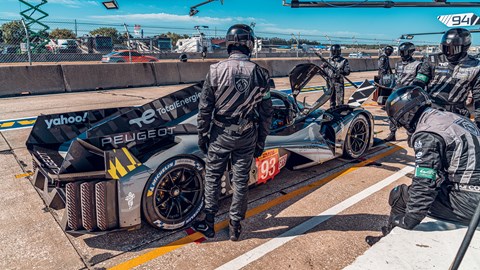
LMDh runs to the same weight and power restrictions as LMH, and for the first time Balance of Performance aims to level the playing field across WEC’s premier class.
The rules were rolled out from 2021 but this year they’re coming on boost. Porsche and Cadillac field LMDh cars, while Toyota, Peugeot, Vanwall and Glickenhaus join Ferrari in LMH. That’s 11 top-flight cars for the 1000 Miles of Sebring. In the 2024 season, BMW and Lamborghini will be among those joining the LMDh runners.
Want to get all the intel first, and access more amazing content from CAR? Become a member of CAR VIP here with a 99p trial!
For Ferrari, LMH was the only game in town. ‘It allows a manufacturer to develop each component, and that is essential for us,’ explains Ferdinando Cannizzo, boss of Ferrari GT track car development. ‘This is our car, so basically we can optimise everything we want – the chassis, the suspension – and transfer all the know-how we have collected in GT racing and Formula 1, which was not possible otherwise.’

I pore over the 499P in Ferrari’s garage, stretching long and low, the red and yellow livery evocative of its 312P forbear. A clean-sheet design that Ferrari began testing at Fiorano only in July, the 499P (499cc per cylinder, Prototype) comprises a full carbonfibre monocoque and bodywork, a 3.0-litre twin-turbo V6 sending 671bhp to the rear wheels, and an e-motor to chuck 268bhp at the front.
Electronics cap the combined total at 671bhp, and ensure all-wheel drive operates only above 119mph so as not to disadvantage rear-drive rivals. That leaves deployment restricted to three high-speed corners at Sebring, where it’s least beneficial…
You soon lock into the 499P’s sonic signature on a busy track – all turbo-heavy flatulence on acceleration and fizzy deceleration like a robot powering down. Watch the onboards and you’ll hear the e-motor spool up over 119mph like a boiling kettle, the high-pitched whiz weirdly disembodied from the V6’s cadence.

Niklas Nielsen was second to drive the new car on its roll-out. ‘There have been massive changes since then and there will be something we can improve after this race,’ he tells CAR. ‘But look how many years’ experience our competitors have with prototype racing, especially Toyota, and other manufacturers have spent at least one year developing the car, so what we’ve done in eight months is really amazing.’
While the design is new, Ferrari has opted for continuity of personnel. It has built on the familiarity of its lengthy relationship with independent outfit AF Corse, its partner for production-based GT racing in the WEC, although the team is greatly expanded and strengthened, including some appointments from F1.
Drivers who have long delivered for Ferrari in GT racing but lack top-level prototype experience dominate – Nielsen has risen through the ranks from the Ferrari Challenge, joining Antonio Fuoco and Miguel Molina in car number 50. Across the garage Alessandro Pier Guidi and British driver James Calado pedal the 51, the latter suffering a worst-case-scenario in the pre-event Prologue.
‘It was cold tyres [tyre warmers are dubiously off-limits in the WEC on environmental grounds], I was going easy, fourth gear, and I got wheelspin,’ explains Calado. The subsequent loss of control put him in the Turn 1 wall, and while the impact wasn’t huge, the chassis was damaged – 51 gets a fresh one for the race.

Compared with his previous Ferrari GTE racer, Calado says the 499P is more comfortable (‘You’ve got your own seats [as opposed to sharing, with foam inserts], it’s more of a laid-down position, we’ve refined the details’), and highlights the huge number of settings to change on the steering wheel (‘Almost F1 complexity, sometimes corner-by-corner’) and the leap in both downforce and increased performance thanks to the electric motor at the front. ‘The difference in performance is huge – probably 14 seconds per lap,’ he grins.
Friday morning, race day, and I find myself sharing a golf buggy with former Formula 1 Alfa Romeo Racing driver and current Scuderia Ferrari reserve Antonio Giovinazzi – the better to navigate Sebring’s vast concrete expanses and grab a little shade from 25ºC temperatures that burn way hotter.
The Italian has driven in GT and LMP2 previously, is well versed in hybrid systems thanks to F1 and Formula E drives, and joins team-mate Calado in the 51. Only from his perspective the 499P is slower. Giovinazzi notes the increase in weight by around 200kg versus F1, a decrease in downforce and power and the fact he can take more kerb. Crucially, though, it’s the mental approach that requires more adaptation than the car itself.
‘You drive knowing you will hand over to your team-mate, so you want the best car for them, the tyres, everything. The out lap on cold tyres with other cars around will be tricky, and the traffic of GT and LMP2 is also quite tough – you need to be consistent and lose less time than the others,’ says Giovinazzi. With all Ferrari’s LMH drivers more accustomed to being overtaken in GT cars than passing them in prototypes, this is a big potential weakness.
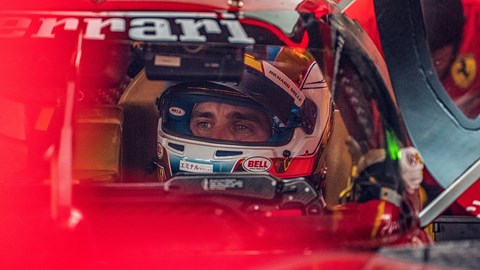
Cockpits shielded by silver sun shades, competitors line up on the Ullman Straight for the pre-race grid walk, the huge Le Mans centenary trophy dangled like a carrot at the end. Giovinazzi’s team-mate Pier Guidi is taking the rolling start from fourth following a 1min 45.874sec quali time some eight tenths off its pole-sitting sibling. Two Toyotas split the difference, the lone Cadillac lines up in sixth (1min 46.082sec), the Porsches, Peugeots, Glickenhaus and Vanwall increasingly distant in the low 47s to low 49s.
We dash down to Turn 1 ahead of the midday rolling start, a vast expanse of the very same concrete laid for the original airfield in 1941, as a distant but ever-increasing buzz rises from the pack nearing the end of the formation lap. When the safety car pits, Fuoco leads them flat out in the number 50 Ferrari – the cars visibly bite and grab at the coarse surface, bumping around aggressively. The pace is intense from the off, push, push, push.
I’m watching them disappear into the distance for a few laps when a Ferrari 488 contesting the entry-level GTE Am class runs wide, lifts the throttle and smacks a tyre wall backwards, a blur of sand, tyres and rolling metal tossed high like it’s hit an IED.
Thankfully the driver’s okay, but the shunt brings out the safety car and triggers a generally scrappy start to proceedings – one that sees Ferrari squander its advantage generally. The pole-sitting car 50 receives a penalty for overtaking under safety-car conditions, anerror compounded by an infringement under refuelling.
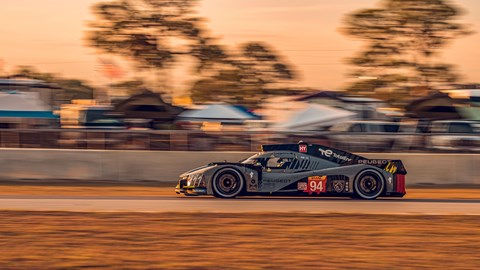
But it’s Peugeot that’s having the real shocker, one car trundling around looking a bit lost almost from the off on a day when they’ll never be in contention. By the time things settle the Toyotas have reasserted themselves in the top two positions, with the Ferrari, Cadillac and Porsche all potential podium finishers. The Glickenhaus and a Peugeot have retired.
Time for a chat with Antonella Coletta, who’s in a modest little prefab a far cry from F1 motorhomes. For the team boss, Sebring is all about gaining experience and proving the 499P’s reliability on a bumpy track that will not only stress the suspension, but also the engine and gearbox, given how often slicks leave the surface and the revs spike – Ferrari has tested here twice before as well as elsewhere with a 24-hour simulation where ‘we had some problems’. The target? ‘The first target is to make it to the end – we have seen some competitors have a difficult first weekend. We want to avoid that,’ says the 56-year-old. The second target? ‘A podium.’
When I check the timing boards at 5.10pm, Toyota are fully two laps ahead when disaster strikes for the number 51 Ferrari – Pier Guidi touches a GTE Am car at Turn 16, spins across the track and smacks a Porsche 911 before coming to rest on the run-off. His left rear tyre is deflated, rear bodywork scattered over the surface.
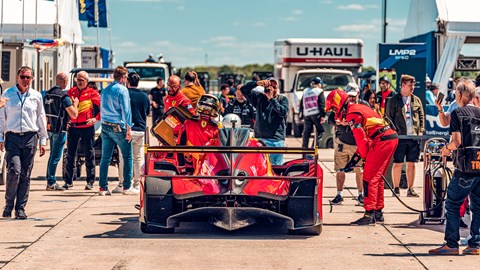
Mechanics swarm over the car in the pitlane after he limps a full lap back round, the rear bodywork torn to naked carbonfibre like a shark’s been at it. The 51 gets back on track but soon it’s wheeled into the team garage for a more thorough investigation, over 20 precious minutes dragging by.
Picture a badly drawn alligator head with open jaws pointing left and you’ll grasp the Sebring layout. We’ve stayed mostly in the lower jaw that houses pits and paddock thus far, so we cross over a bridge into the mouth, then cross again to explore Turns 7 to 13 – the nostril to the eye.
For an airfield circuit with no elevation, the race is far more watchable than expected – cars duelling through the narrow sections between high kerbs is addictively edgy, and it’s a buzz watching them wind up from the hairpin at Turn 7 through the fast flicks of 8 and 9, flat out, total commitment as they trust in the grip and downforce.

This is also an incredibly evocative atmosphere. Jacked pick-up trucks, RVs and stars-and-stripes flags are scattered through the camping area, with a handful of slash pines and southern live oaks draped with Spanish moss the only respite from searing sun. The rich tang of flame-grilled meat hangs on a light breeze.
Ferrari’s faithful are out in force. F1 fan Franco Filice is attending Sebring for the first time, drawn to see how his favourite team get on with the 499P. Adam Fettarman has been coming here since he was eight or so, and remembers watching the Ferrari 512 BB as a child. ‘Toyota just crushes the field, but Ferrari has done a good job and it’s been interesting to see them come back with so many other manufacturers, that’s exciting,’ he shouts over track traffic. A generational thing, he’s here with his son and one-time Ferrari-owning dad.
When we head to the lairier Green Park area, where fans have
knocked up not just makeshift viewing platforms but entire bar areas, the vibe seems overwhelmingly good-natured despite – and perhaps because of – the many discarded bottles and cans. It’s where we meet three grown men dressed as Holsteins – aka the Sebring Cows.

‘In 1993 someone dressed up as a cow and people kept giving them beer,’ explains a school teacher who’d prefer not to be named, ‘so they said “this shit’s great, we’re all wearing cow suits next year”. The Herd was born.’ In a break with protocol, the cows give us beer.
Into the last hour, the sun’s softened from white hot to warm orange as it falls into the drivers’ eyeline just as the pace really intensifies. The Ferraris pound round in third and seventh, the Toyotas way out of reach up front, Cadillac still in with a shot at the podium.
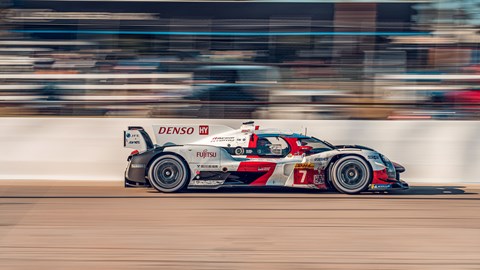
We’re standing at Turn 13, watching the cars flash by in a barrage of pops, rumbles and futuristic fizzes, when a launch out of Cape Canaveral streaks across the sky in the race’s closing stages. We’re so busy soaking it all up that we lose track of what’s actually going on, but eventually fireworks pop in the sky and we learn Mike Conway has taken the win for Toyota, just two seconds ahead of team-mate Brendon Hartley. Ferrari number 50 is two laps down but bags third, chased to the flag by the lone Cadillac 10 seconds behind. The second Ferrari is down in seventh.
Pole and a podium on the 499P’s debut is quite the marker, and the opposition know it. ‘Today is just the start of the big race coming for 2023,’ sums up Toyota’s Kamui Kobayashi post-race.
The stars are certainly aligning for that Le Mans centenary.